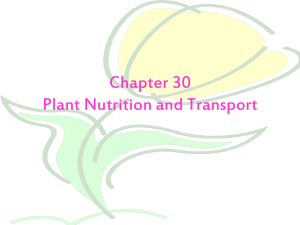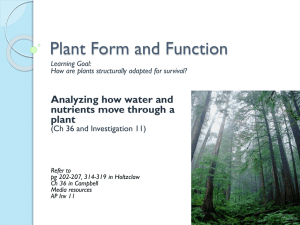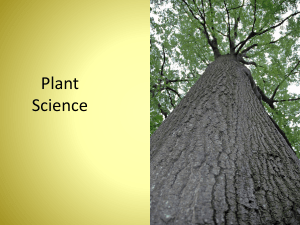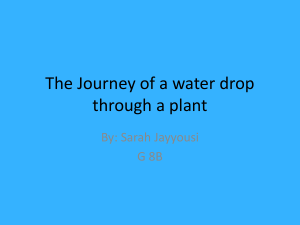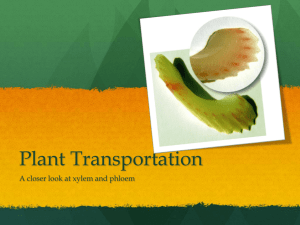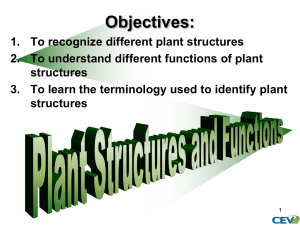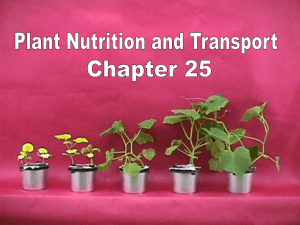Answers to Mastering Concepts Questions
advertisement
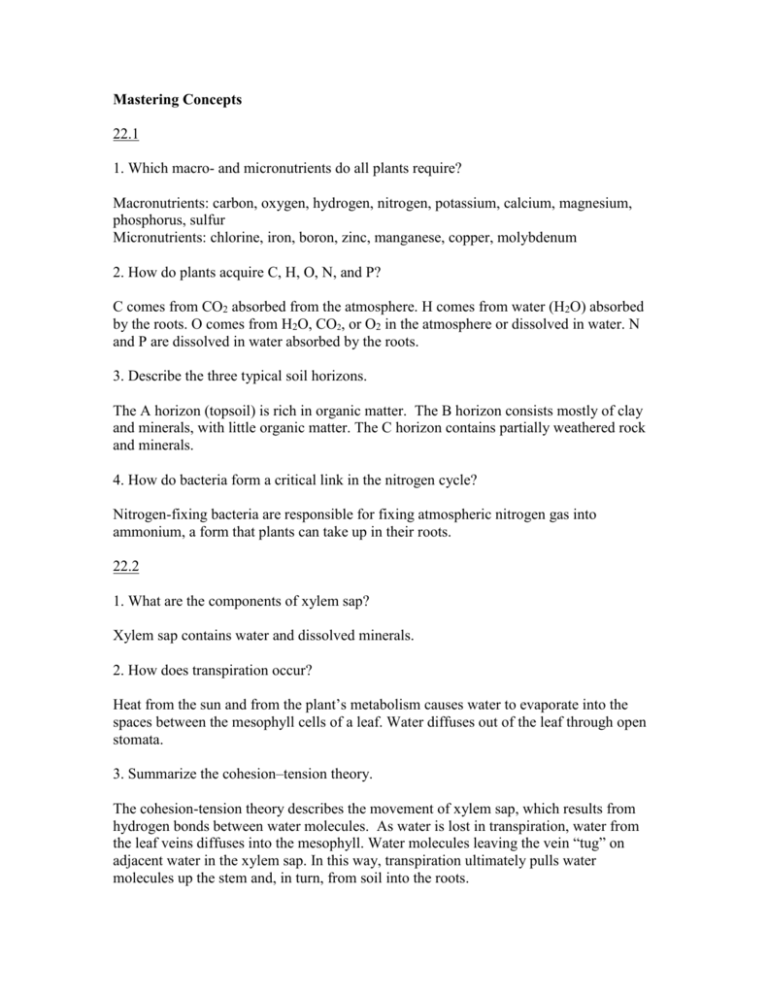
Mastering Concepts 22.1 1. Which macro- and micronutrients do all plants require? Macronutrients: carbon, oxygen, hydrogen, nitrogen, potassium, calcium, magnesium, phosphorus, sulfur Micronutrients: chlorine, iron, boron, zinc, manganese, copper, molybdenum 2. How do plants acquire C, H, O, N, and P? C comes from CO2 absorbed from the atmosphere. H comes from water (H2O) absorbed by the roots. O comes from H2O, CO2, or O2 in the atmosphere or dissolved in water. N and P are dissolved in water absorbed by the roots. 3. Describe the three typical soil horizons. The A horizon (topsoil) is rich in organic matter. The B horizon consists mostly of clay and minerals, with little organic matter. The C horizon contains partially weathered rock and minerals. 4. How do bacteria form a critical link in the nitrogen cycle? Nitrogen-fixing bacteria are responsible for fixing atmospheric nitrogen gas into ammonium, a form that plants can take up in their roots. 22.2 1. What are the components of xylem sap? Xylem sap contains water and dissolved minerals. 2. How does transpiration occur? Heat from the sun and from the plant’s metabolism causes water to evaporate into the spaces between the mesophyll cells of a leaf. Water diffuses out of the leaf through open stomata. 3. Summarize the cohesion–tension theory. The cohesion-tension theory describes the movement of xylem sap, which results from hydrogen bonds between water molecules. As water is lost in transpiration, water from the leaf veins diffuses into the mesophyll. Water molecules leaving the vein “tug” on adjacent water in the xylem sap. In this way, transpiration ultimately pulls water molecules up the stem and, in turn, from soil into the roots. 4. How do water and dissolved minerals enter roots and move through the endodermis to the xylem? Water and dissolved minerals enter roots through root hairs and the filaments of mycorrhizal fungi. Once inside the root, water and dissolved minerals move toward the xylem by creeping between cells of the cortex and by moving through plasmodesmata of cells. Once they reach the Casparian strip of the endodermis, water and dissolved minerals are forced to go through the cell membranes to reach the xylem. 5. How do the cuticle and stomata help plants conserve water? The cuticle is a waxy barrier that retards water loss from aboveground plant tissues. Guard cells close stomata when conditions are hot and dry, reducing the evaporation of water from leaf tissues. 22.3 1. What are the components of phloem sap? Phloem sap is a solution containing organic compounds combined with water and minerals from the xylem. 2. Explain the pressure flow theory of phloem transport. The pressure flow theory states that phloem moves under positive pressure from sources to sinks. A source is a structure that produces or releases sugars, and a sink is a plant part that does not carry out photosynthesis. 3. What are some examples of sources and sinks in a plant? Examples of sources are leaves, stems, or other green plant parts. Examples of sinks are roots, fruits, shoot apical meristems, storage organs, flowers, or other plant parts that do not carry out photosynthesis. 4. What is the evidence for the pressure flow theory? Evidence includes the observation that phloem sap moves through an aphid’s mouthparts even if the insect itself is cut away. In addition, microscopes have clarified some of the details of phloem function. 22.4 1. What is a haustorium? A haustorium is a connection between a parasitic plant and the vascular tissue of the host plant. 2. Briefly describe how a parasitic plant infects a host. After the seed of a parasitic plant germinates, the seedling secretes an adhesive material that attaches the seedling to the host. As the seedling’s roots develop they penetrate the epidermis of the host and form a haustorium within the vascular tissue. 22.5 1. Describe the hypothesis and experimental design in Ellison and Gotelli’s study. Ellison and Gotelli hypothesized that carnivorous plants are not abundant because of an evolutionary trade-off: insect traps cost the plant so much leaf area that they are not adaptive in nutrient-rich environments. The experiment was set up with nine treatment groups of varying nutrient compositions over a period of three years. At the end of each year the shape of each leaf and its keel size were recorded. 2. Explain the purpose of the two control solutions. N and P were mixed into a solution of water and micronutrients. The two control solutions eliminate the possibility that water and/or micronutrients could account for the treatment effects that Ellison and Gotelli observed. 3. Predict how the graph in figure 22.13 would look if nitrogen did not affect leaf morphology. If nitrogen content did not play a role in leaf shape, then the data points combining phosphorus and nitrogen would cluster around the data points already on the graph for phosphorus alone. Write It Out 1. On a planet with an atmosphere similar to Earth’s, which elements would have to be present for earthly plants to grow? All of the 16 essential macro- and micronutrients must be present in the atmosphere and soil. 2. How do plants obtain carbon and nitrogen? Plants obtain carbon from the atmosphere in the form of CO2 gas, which diffuses through tiny pores called stomata. Plant roots absorb nitrogen from soil. 3. Clover is a legume that requires nitrogen, as does every other plant. How would planting clover in a crop rotation reduce the need for nitrogen fertilizer? Rotating crops with clover would allow the clover to fix the nitrogen in the soil with the help of the nitrogen-fixing bacteria, Rhizobium. This would raise the nitrogen content available for other crops and reduce the reliance on fertilizers. 4. How might transgenic technology (see chapter 7) be used to endow plants with the ability to fix nitrogen without the aid of bacteria? In what ways would this new feature change agriculture? In theory, genes encoding enzymes required for nitrogen fixation could be moved from nitrogen-fixing bacteria and inserted into the chromosomes of a plant. It would be potentially valuable to agriculture because plants could fix their own atmospheric nitrogen, which would reduce the need for nitrogen fertilizers. 5. Why don’t plants grow in a path that has been trampled by repeated foot or vehicle traffic? Trampling by repeated foot traffic erodes away the topsoil containing the majority of nutrients necessary to support plant life. In addition, compressing the soil makes it difficult for roots to obtain water and nutrients. 6. Use the Internet to learn about soil conservation. How do soil conservation practices work, and why are they important? Research the historical factors and farming practices that led to the Dust Bowl. [Answers will vary] 7. When Chris mows the grass, she faces a choice between discarding the clippings and leaving them on the lawn. How would each choice influence the nutrient content of the soil? Explain your answer. If she discards the clippings then the organic material and nutrients in the clippings are removed from the ecosystem of her yard. If she leaves the clippings then they can be broken down by soil bacteria and the nutrients will be released for further plant growth. 8. Some plants “hyperaccumulate” metals such as nickel. Their tissues contain nickel concentrations that would be toxic to most other plants. How might hyperaccumulation be adaptive to the plant? How might people put hyperaccumulators to practical use? Since nickel is toxic in high concentrations, plants able to accumulate it in their tissues would be able to deter herbivores. People could use this attribute to make non-food crops such as cotton less appealing to herbivores, or they could use plants to clean up toxic nickel soils after an industrial accident. 9. Trace the path of water and dissolved minerals from soil, into the root’s xylem, and up to the leaves. Water enters the roots by osmosis; dissolved minerals enter root cells by passive or active transport. After passing through the epidermis, the water and minerals may move between or within cells of the cortex. Once the water and minerals encounter the endodermis, the Casparian strip forces water and minerals into cells. They next enter the xylem and are pulled up the stem and into leaves. Water vapor moves out of the stomata as part of the transpiration stream. 10. Explain how cohesion plays a part in xylem transport. As water molecules evaporate from the leaf, new molecules diffuse in from the vein. Neighboring water molecules, attached by hydrogen bonds, are pulled up the stem and into the vein. In turn, water is also pulled from roots into the stem, and from the soil into the roots. 11. Are roots necessary for transpiration to occur? Are leaves? Explain your answers. Transpiration is the loss of water through stomata in leaves. Leaves are therefore necessary for transpiration to occur. Roots are not necessary, however, as long as the cut stem can replace water lost in transpiration. 12. Suppose you use a rubber band to secure a clear plastic bag around a few leaves on a live plant. What do you think will happen? Water will accumulate in the bag from the process of transpiration. In addition, the composition of the gas inside the bag will change: O2 will become more abundant, and CO2 will be depleted. 13. “Root pressure theory” proposes that water from roots is pushed up a stem. Although root pressure does occur in some circumstances, it does not account for all xylem flow. What evidence would you look for to determine whether water in xylem moves under tension or pressure? To determine whether water moves by tension or pressure, a stem should be cut. If root pressure is responsible for xylem transport, then water should come out of the end of the stem that is still attached to the roots. 14. During what time of day is a plant at greatest risk for the formation of air bubbles in the xylem stream? Air bubbles pose the greatest risk during the hottest, driest part of the day, when transpiration is most rapid. 15. Use osmosis to explain why plants would have a hard time extracting water from extremely salty soil. The salts in the soil would draw water out of the roots by osmosis, countering the movement of water into the roots. 16. Review C3, C4, and CAM photosynthesis in chapter 5. Explain how plants that use each pathway conserve water. Like all land plants, C3 plants have a waxy cuticle and stomata that conserve water. C4 plants have smaller, fewer stomata than do C3 plants. CAM plants conserve water by closing their stomata during the hot daylight hours. 17. Angiosperms have both tracheids and vessel elements; conifers and ferns have only tracheids. Propose a hypothesis that explains how xylem with vessel elements might be advantageous over xylem that contains only tracheids. In what circumstances might tracheids-only xylem be adaptive? Answers for the hypothesis. One example might be that in an environment with abundant water, vessels allow faster, more efficient xylem transport. Tracheids only xylem might be adaptive in environments with frequent drought, where plants with vessels would be more subject to air bubble formation. 18. What special water transport problems do plants encounter in habitats subject to periodic flooding or prolonged drought? In habitats with periodic flooding, soils may be saturated with water; roots may die for lack of oxygen in such soils. With prolonged drought, plants may not be able to replace the water lost in transpiration. 19. Distinguish between a source and a sink. How can the same plant part act as both a source and a sink? A source is any plant part that produces or releases sugars; a sink is any plant part that does not carry out photosynthesis. The same plant part can act as both a sink and a source, because a sink may store carbohydrates that are later released to the rest of the plant. 20. How does xylem flow influence phloem flow? When sugars are loaded into the phloem, osmosis draws water from the xylem into the phloem. The resulting increased pressure in the sieve tubes drives the phloem sap away from the sugar source and toward a sink. 21. Peach and nectarine growers remove some flowers and small, immature fruits from trees. Why does this practice yield larger, higher-quality fruit? Removing some flowers and small fruits reduces the number of sinks, ensuring that the remaining sinks will receive more sugar. 22. Suppose that a scientist exposes a leaf to CO2 labeled with carbon-14, and the radioactive carbon is incorporated into organic compounds in photosynthetic cells. At various times after exposure, the scientist can determine the location of the radioactive carbon in the plant. In what tissues do you expect to find the radioactive material immediately after exposure to the labeled carbon? What about during transport? When transport is complete, will the radioactive material be in plant parts above the leaf, below the leaf, or both? The radioactive 14C enters the leaf through stomata and is used immediately in photosynthesis in a mesophyll cell. During transport, the 14C should be present in phloem sap. The phloem may transport the sugar to any sink such as a flower, fruit, or root, and therefore the 14C may end up either above or below the leaf. 23. Scientists studying phloem function find that if they use a tiny instrument to damage sieve tubes, the plant begins to plug the wound within a minute. Why is it adaptive for the plant to prevent leakage of phloem sap? It is adaptive for the plant to prevent leakage of phloem sap because it contains the sugars that support all nonphotosynthetic plant parts. 24. Make a chart comparing xylem and phloem transport. Include sap composition, characteristics of the conducting cells, how the sap moves, whether the transport costs energy, and direction of flow within the plant. CHARACTERISTICS Sap composition XYLEM Water and minerals Conducting cells Sap movement Energy costs Tracheids and vessels Transpiration pulls water from soil to roots to stems None Direction of flow Roots to leaves PHLOEM Water, sugars, other organic molecules Sieve tube elements Sap moves under pressure from source to sink Requires active transport to load sugars into sieve tube Sugar source to sink 25. At which points in the transport of xylem sap and phloem sap does osmosis occur? At which points does active transport occur? Osmosis brings water into roots. Osmosis also moves water from the xylem to the sieve tubes (when the sieve tubes contain a high concentration of sucrose) and in the opposite direction (when the sucrose has been unloaded from the sieve tubes). Active transport occurs when loading the sucrose into the sieve tubes and unloading at the sink. In addition, some minerals enter the roots by active transport. 26. Explain two ways that leaf mesophyll cells and root cortical cells interact. Photosynthesis in leaf mesophyll cells produces sugars that nourish root cells. Roots absorb water and minerals that the leaf mesophyll cells require to carry out photosynthesis. 27. Taylor has a tree with mistletoe. He thinks he can solve the problem by knocking the mistletoe off the branches. How would you explain why the only effective treatment is to prune off infected branches? Knocking off the mistletoe will only eliminate the part of the plant that emerges from the branch; the mistletoe can grow back from the parts that were not removed. Pruning away infected branches, however, eliminates all of the mistletoe. 28. Pitcher plants are threatened in the wild by habitat destruction (urban development, draining for forestry, runoff of herbicides, fire suppression) and collection for plant trade. Researchers are also concerned that air pollution will deposit additional nitrogen on soil. Why would additional nitrogen be a concern for pitcher plants? Additional nitrogen would result in a shift in leaf shape, selecting for a small diameter pitcher and a larger keel (and eventually the loss of the pitcher). Continued added nitrogen might change the selective pressures in the habitat, so that pitcher plants might no longer be able to compete against other plant species. 29. In the early 1600s, Jean Baptista van Helmont investigated how plants acquire new mass as they grow. He weighed and planted a willow shoot into soil that he had also weighed. After 5 years of adding nothing but water to the plant, he found that the soil had lost only a little weight, while the plant had grown from 2 kilograms to about 76 kg. He therefore concluded, incorrectly, that water was the sole source of the added plant material. What other source did he fail to consider in his experiment? He did not consider the CO2 from the atmosphere as a source of plant material. 30. Long-term space travel will require the construction of on-board “closed loop” ecosystems that will produce food and oxygen for astronauts. Suppose you are a NASA engineer designing such an ecosystem. Brainstorm the characteristics of the ideal space plant. Which microbes would you need to include? How would the astronauts interact with the ecosystem? What problems can you foresee with growing plants in space? Some possible characteristics include: provide a lot of edible parts, require little water and growth space, grow rapidly in low light. You would need microbes to decompose the inedible plant parts and to fix nitrogen. The astronauts would eat the plants, use O2 in respiration, provide CO2, and add waste material to the soil. Many potential problems exist. Some could include: the lack of gravity to direct root growth; the risk that a disease-causing organism could wipe out all of the plants, leaving the astronauts to starve; and lethal changes in the composition of the on-board atmosphere (e.g., the depletion of O2 by soil microbes). 31. Phytoremediation is the use of plants to treat environmental problems. Search the Internet for applications of phytoremediation. What are the benefits of phytoremediation? If you were trying to discover plants suitable for use in phytoremediation, what qualities would you look for? Can you foresee any problems with phytoremediation? Some benefits could include lower cleanup costs, safety, and low levels of environmental disturbance. Desired qualities in the plants could include the ability to accumulate large amounts of the toxic material without harm to the plant, which might either store the material or convert it to a nontoxic form. Some problems could include introducing concentrated levels of the toxin into the food chain, the possibility that toxins might exist beyond the reach of the plant’s root system, and extended time requirements if the plant's growth rate is low. 32. Some architects specialize in building living roofs covered with plants. What are the benefits and risks of living roofs? What raw materials must be supplied to plants living on a roof? What types of plants would be the best choice? How does your answer depend on where you live? Benefits may include reduced CO2 and pollutant levels, insulation for the building, and the provision of habitat for wildlife. Risks may include threats to the integrity of the roof (e.g., increased weight or water damage) and the death of roof plants in extreme conditions. Raw materials might include fertilizer, a way to capture and distribute water, and a thin layer of soil. Plants should be evergreen and should have shallow roots, relatively short stature, and the ability to withstand seasonal weather extremes. Pull It Together 1. Add the terms soil, source, sink, pressure flow, and transpiration to the concept map. Roots grow in soil. Phloem sap moves by pressure flow from source to sink. Transpiration is the loss of water through open stomata in the leaves. 2. What role do the stomata play in transpiration? Stomata are the openings through which water evaporates from the plant. 3. What are examples of sources and sinks in phloem transport? Flower and roots are sinks because they create no sugars, whereas leaves and stems are sources because they create sugars via photosynthesis. 4. Which nutrients do roots absorb from soil, and which do leaves absorb from the atmosphere? Roots absorb all mineral nutrients, including nitrogen, potassium, and phosphorus, from soil. Oxygen and hydrogen also come from water absorbed from soil. Leaves absorb carbon dioxide gas from the atmosphere. 5. Besides sugar, what other organic substances does phloem transport? The phloem sap also carries amino acids, hormones, enzymes, and messenger RNA.

